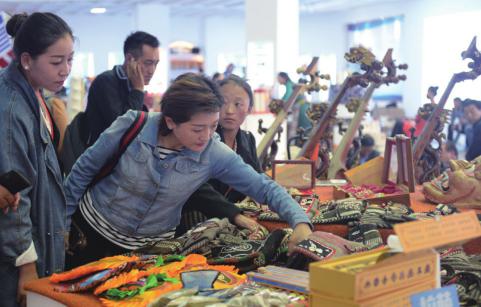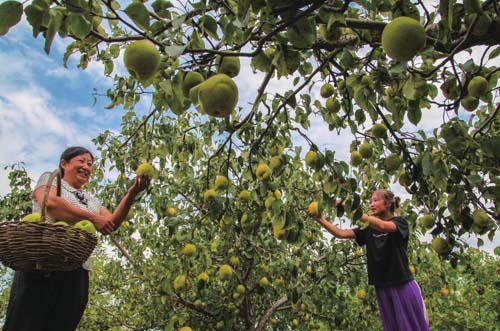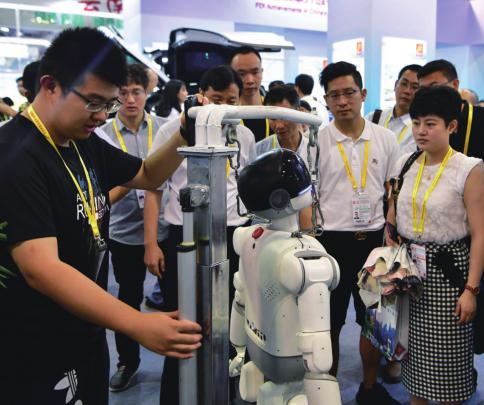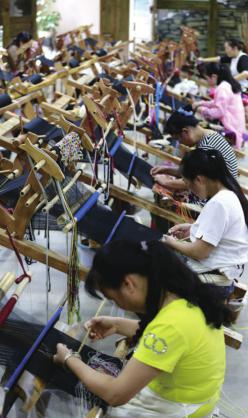Destination Hong Kong
A mainland resident shows her ticket for a bullet train from Shenzhen North Station in south Chinas Guangdong Province to Hong Kongs West Kowloon Station. The Guangzhou-Shenzhen-Hong Kong high-speed railway will offi cially start operation on September 23.
Urbanization Progress
China has made steady progress in urbanization during the past 40 years thanks to its reform and opening up, with a rapidly growing population of city dwellers.
Permanent urban residents totaled 810 million at the end of last year, up by 640 million from 1978, with an annual average increase of 16.44 million, the National Bureau of Statistics (NBS) said in a report on September 10. The urbaniza tion rate stood at 58.52 percent, surging from 17.92 percent four decades ago.
The number of cities more than tripled between 1978 and 2017 to reach 661. A total of 16 cities boast more than 5 million residents according to household registration data, while only Shanghai had reached that level 40 years ago.
Chinese cities are seeing stronger overall competitiveness and have a positive outlook, the NBS said.
There has been signifi cant improvement in public transport and infrastructure in cities. The total track length of rail transit in 32 cities stood at 4,484 km at the end of 2017, up from 23.6 km, only seen in Beijing four decades ago. The number of buses rose from 17,000 in 1978 to 477,000 in 2016 in prefecture-level cities.
The livelihood of urbanites has also improved dramatically as disposable income soared by 14.4 times to 36,396 yuan ($5,322) from 1978 to 2017. The urban employed fi gure stood at 424.62 million people at the end of last year.
Mass Entrepreneurship
China will upgrade its mass entrepreneurship and innovation campaign to boost employment, promote technological innovation and stimulate industrial growth, a State Council executive meeting said on September 6.
The meeting decided that further steps will be taken to create a more enabling environment for entrepreneurship and innovation initiatives.
Such steps include further streamlining administration and delegating powers, making it easier to start new businesses, advancing reform for simplifi ed enterprise deregistration, formulating detailed policy incentives to encourage scientifi c researchers to start their own businesses and improving policy support and services for migrant workers returning to their hometowns or ex-service people who wish to engage in entrepreneurial activities.
Financial support and tax incentives for entrepreneurship and innovation will be enhanced. Innovative enterprises with prominent potential but which are not yet profi table will also be encouraged to become listed and apply for fi nancing.
Pilot programs will be carried out to grant long-term usage rights and ownership to researchers for jobrelated scientifi c or technological achievements and to provide compensation to cover loan risks in the commercial use of such achievements.
The meeting also called for efforts in seeking innovation creditworthiness oversight and urged companies operating on sharing economy platforms to fulfi ll their responsibilities in ensuring safety and product quality.
Credibility of Charity
The Ministry of Civil Affairs has intensifi ed a campaign to crack down on dishonest behavior in charity work.
A regulation released by the ministry requires charities to provide factual information to the public in a complete and timely manner. This is part of the ministrys campaign to increase the credibility of charity organizations.
According to the regulation, which took effect on September 1, required information to be disclosed includes charity groups public donations, major asset changes, transactions and investments.
The ministry has established a Charity in China website that publishes information about charities.
Earlier this year, China established a mechanism that shares information on charities credibility, specifying f vie types of dishonest entities including charities, donors and benef ciiaries that will be blacklisted, and outlined 24 punishment measures.
Tip-off channels will be improved and punishment on dishonest behavior toughened, while anyone who is found to be involved in donation fraud will be transferred to public security authorities, the ministry said.
Bone Marrow Donation
The China Marrow Donor Program(CMDP) announced that it had enlisted 2.5 million potential donors and facilitated more than 7,600 hematopoietic stem cells donations by the end of August.
Hematopoietic stem cells are the stem cells that give rise to all blood cell types. They are found in bone marrow and used to treat blood diseases such as leukemia.
Over 300 donations were made for patients from more than 20 foreign countries and regions, said the CMDP at an event in Beijing on September 12 to celebrate the Fourth World Marrow Donor Day, which fell on September 15 this year.
The CMDP is a leading bone marrow bank established in 1992 by the Red Cross Society of China.
School Food Safety
The Ministry of Education (MOE) released a circular calling for better food safety work for the nutritional improvement plan for students on September 7.
Schools in pilot regions of the plan should check the sanitary conditions of their canteens and eliminate potential risks by checking the expiration date of food and fl avoring, as well as supervising the management to fi nd potential problems.
They should strictly implement laws and rules on food safety, continue to improve food safety management, and modify their contingency plans for food safety issues, according to the circular.
The MOE also called for measures including strengthening supervision over food suppliers, improving the disinfection of tableware and carrying out regular checks.
Launched in November 2011 for primary and middle school students in rural areas, the nutritional improvement plan offered schools subsidies to build canteens or outsource breakfast and lunch from catering companies, as well as free nutritional packages for infants and information on healthy nutrition for their guardians.
Natural Paradise
Demoiselle cranes fl y over the grassland of Barkol Kazak Autonomous County, Hami City, northwest Chinas Xinjiang Uygur Autonomous Region, on September 11.
Next-Generation Subway
Chinas leading train producer released its next-generation subway train that is more intelligent and energy saving at a recently concluded expo in Changchun, capital of northeast Chinas Jilin Province.
Equipped with an unmanned operating system, the train is fully automatic in all functions including maintenance and locomotion, said Wang Zhonghai, a technical expert with CRRC Changchun Railway Vehicles Co. Ltd,.
An intelligent system can monitor the trains operating state, and safety equipment installed on the train can detect roadblocks and derailment to signifi cantly increase its safety, Wang said during the expo that concluded on September 10.
Passengers can watch videos on the smart window displays, and all carriages are equipped with WiFi and incorporate LiFi technology, which uses visible light to transfer data.
3D cameras installed above the train doors can automatically calculate the number of passengers. In special zones, hearing aid equipment can offer assistance to those with hearing impairments.
Made of carbon fi ber, the newgeneration subway train is at least 15 percent lighter than traditional subway cars and can reduce energy consumption by around 15 percent.
Wang did not disclose when the new model will be put into production, only saying that “it will be soon.”
A Feast for the Eyes
Visitors browse handicrafts at the Fourth China Tibet Tourism and Culture Expo in Lhasa, southwest Chinas Tibet Autonomous Region, on September 11.
Trade Boom
Chinas imports rose 13.7 percent year on year to 9.09 trillion yuan($1.33 trillion) in the fi rst eight months of the year, demonstrating the countrys commitment to the multilateral trading system, experts said on September 9.
The countrys two-way trade in goods during the period was 9.1 percent higher at 19.43 trillion yuan($2.83 trillion), with exports up 5.4 percent at 10.34 trillion yuan ($1.51 trillion), according to the General Administration of Customs.
In the January-August period, the export and import of products under the general trade category, differentiated from the processed trade category, gained 13.1 percent from a year ago to 11.43 trillion yuan($1.67 trillion), accounting for 58.8 percent of total foreign trade, about 2.1 percentage points higher than the same period last year.
The countrys trade with major partners saw an increase during the January-August period.
Trade with the European Union, Chinas largest trading partner, climbed 6.2 percent in renminbi terms, while the trade volume with the United States and Southeast Asian countries increased by 5.9 percent and 11.8 percent, respectively.
Trade with economies related to the Belt and Road Initiative totaled 5.31 trillion yuan ($774.3 billion) between January and August, up 12 percent year on year, 2.9 percentage points higher than the average rate of growth for overall trade, offi cial data showed.
Chinas trade in services also reached a record high of 2.98 trillion yuan ($436 billion) between January and July, bolstered by the nations economic resilience and increasing efforts to drive the service sector.
The Ministry of Commerce said that in the fi rst seven months of 2018, Chinas total service trade grew 9.9 percent year on year. Trade in services refers to the sale and delivery of intangible products such as transportation, tourism, telecommunications, construction and advertising.
The ministry attributed the robust expansion to stable domestic economic growth, a set of openingup measures and favorable policy support for the service sector.
Pear Prosperity
Farmers pick pears in Lifengxian Village, Yongqing County, Hebei Province, on September 11.
By following the principle of green development, Yongqing has focused on growing quality fruit in recent years. Orchards now cover an area of 200,000 mu (13,333 hectares) in the county, with total output value exceeding 60 million yuan ($8.75 million).
CPI Rose
Consumer price infl ation had increased at a faster pace than the previous month for three months in a row by August, although the overall infl ation risk remains muted.
The consumer price index (CPI), a main gauge of infl ation, rose 2.3 percent year on year in August, compared with 2.1 percent for July, 1.9 percent for June and 1.8 percent for both April and May, the National Bureau of Statistics (NBS) said on its website on September 10.
The August fi gure was the highest since February, when the CPI was up 2.9 percent year on year, mainly driven by factors related to the Spring Festival holiday.
The pickup was mainly attributed to a fast increase in nonfood prices, which rose 2.5 percent year on year and contributed to a 1.98-percentage point rise in the overall CPI increase.
China is aiming to keep annual CPI growth at around 3 percent this year, the same as the 2017 target.
Average year-on-year CPI growth for the fi rst eight months stood at 2 percent, unchanged from the fi rst seven months, according to the NBS.
The producer price index, which measures the cost of goods at the factory gate, rose 4.1 percent year on year in August, slowing from a 4.6-percent increase in July.
Cross-Border E-Commerce
Chinas cross-border e-commerce is forecast to see its turnover top 9 trillion yuan ($1.3 trillion) in 2018, according to a report released by the China E-Commerce Association.
The report, released on September 8 at the 20th China International Fair for Investment and Trade in Xiamen, southeast Chinas Fujian Province, said that the top 10 sources of Chinas cross-border ecommerce trade in 2017 were Japan, the United States, South Korea, Australia, Germany, New Zealand, the Netherlands, France, Britain and Chinas Hong Kong Special Administrative Region.
Cross-border e-commerce is most active in south Chinas Guangdong Province, followed by Beijing, east Chinas Zhejiang and Shandong provinces, and central Chinas Henan Province for exports via e-commerce.
Tong Xiaomin, Chief Engineer at the Information Center of the Ministry of Industry and Information Technology, said that the Chinese Government supports cross-border e-commerce with both policy and relevant infrastructure construction.
Globally, however, trade protectionism in the form of tariff barriers and anti-monopoly investigations has had a negative infl uence on the development of cross-border ecommerce, Tong said.
He suggested that Chinese ecommerce fi rms and importers should take heed of changes in the international trade environment and improve their global competitiveness. Meanwhile, e-commerce platforms themselves should explore new markets and adopt new technologies and applications to ensure high-quality growth.
Android Innovation
An exhibitor introduces a humanoid robot to visitors at the 20th China International Fair for Investment and Trade, which opened in Xiamen, southeast Chinas Fujian Province, on September 8.
Energy Transition
China is an “undisputed leader” in the worlds energy transition as the country transforms its energy mix to sustain rapid economic growth and protect both local environments and the global climate, leading energy and shipping certifi cation agency DNV GL said in a report on September 10.
Chinas target is for renewables to account for 27 percent of power generation by 2020, while electricity is the focus of the energy transition, according to DNV GLs latest Energy Transition Outlook.
The Norway-based international certifi cation agency predicted that the energy mix of Greater China will change dramatically over the next two decades.
Currently, 82 percent of the regions energy demand is supplied by coal and oil, with coal by far the largest source, the report said.
From 2023, coal use will start to decline, fi rst slowly and later more rapidly, and by 2050 it will supply only 11 percent of total energy, according to the report.
Oil use will continue to show robust growth and will peak in 2030 at a level 41 percent higher than today. Natural gas will grow its share in total energy use from 7 percent today to 19 percent in 2050.
China is leading global growth in wind and solar photovoltaics, two sources which combined will provide 39 percent of the regions energy by 2050, the DNV GL report said.
NEV Sales Surge
Chinas sale and production of new energy vehicles (NEVs) maintained fast growth in August amid government efforts to encourage their use, industry data showed on September 11.
NEV sales went up 49.5 percent year on year to 101,000 units in August, while production rose 39 percent to 99,000 units, the China Association of Automobile Manufacturers (CAAM) said in an online statement.
Sales of pure electric vehicles rose 31.7 percent year on year in August to 73,000 units, while those of plug-in hybrid vehicles soared by more than 130 percent to 28,000 units, CAAM said.
In recent years, China has intensifi ed efforts to encourage the use of NEVs to ease pressure on the environment by offering tax exemptions and discounts for car purchases.
China has remained the worlds largest NEV market for three consecutive years, with some 777,000 cars sold in 2017.
Smooth as Silk
Workers weave Tujia silk in a workshop in Wulingyuan District, Zhangjiajie, central Chinas Hunan Province, on September 10.
Designers and weavers provide professional advice and make customized products for consumers according to individual demand, which has proved to be a successful business model.

